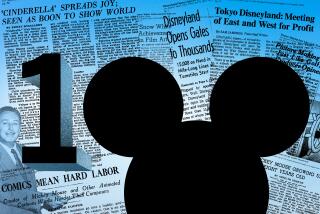The One That Got Away : With ‘Doug,’ Nickelodeon’s Loss May Be Disney’s Gain
- Share via
Viacom’s hyper-competitive chairman, Sumner Redstone, wasn’t happy to learn recently that Walt Disney has an animated movie version of the children’s animated TV series “Doug” coming out this month.
It still sticks in the media mogul’s craw that Viacom’s hip family label, Nickelodeon, dropped the ball three years ago and let Disney get hold of one of its top-rated programs and coveted kids’ franchises.
The result is sweet vindication of sorts for Disney, whose pockets Nickelodeon had picked for years when it came to children’s programming. If the movie is successful, the “Doug” franchise could be worth more than $100 million to Disney.
When Nickelodeon failed to exercise its option to order 13 new episodes of the show after the first 52, Disney snapped up the franchise in early 1996 by making a multimillion-dollar deal with the show’s creator, Jim Jinkins, and his partner, David Campbell. The arrangement included buying the partners’ New York-based company, Jumbo Pictures, for about $5 million in cash and signing them to five-year contracts, with stock options, to be Disney executives.
The deal was finalized about seven months after Disney first announced plans to buy Cap Cities/ABC. In its first season, the renamed “Brand Spanking New Doug” series (since called “Disney’s Doug”) became the cornerstone and highest-rated new program on ABC’s Saturday morning lineup. In its second season, it’s a key contributor to making the network No. 1 in Saturday morning ratings.
Although Nickelodeon retains the right to distribute the original 52 episodes it financed--which still air on Viacom’s United Paramount Network and in syndication--Disney bought the Doug trademark and rights to all future products in all media, including publishing and merchandising.
Bill Gross, a former talent agent who is Jumbo’s senior vice president and general manager, said Jumbo is building the licensing “really slowly.” Disney has active licenses with Mattel for plush toys, with plans for games and puzzles. In addition, negotiations are underway with interactive game companies for “major game publishing,” Gross said.
Gross also said that Jumbo has an “aggressive” publishing program with Disney’s Buena Vista Publishing Group. In conjunction with “The First Doug Movie”--which opens in theaters March 26--there will be a storybook featuring new characters and a 30-minute live stage show at the Disney/MGM Studios Themepark Tour in Florida.
Like the TV series, the movie follows the misadventures of a quirky and imaginative 12 1/2-year-old named Doug Funnie and his friends, who face real kid issues as they grow up.
In a phone interview from their production headquarters in New York City, Jinkins and Campbell talked about the origins of “Doug,” how Nickelodeon let the franchise get away and how excited they are to be executive producers of their first movie.
Since he created “Doug” in the mid-1980s, “a lot of miracles have happened,” said Jinkins, explaining that the character did not originate as a TV personality but rather was the result of “me doodling and amusing myself in a very, very bad year.”
That year--1984-85--his career as a graphic designer and performer “dried up,” a relationship failed and he suffered a sports injury.
“This character kept reoccurring--my alter ego--and he wasn’t a cute 11 1/2-year-old. . . . There were some very dark things,” said Jinkins, who later would base some “Doug” adventures on his own childhood in Richmond, Va. Although the series “is not autobiographical, emotionally it’s very accurate,” he said.
It was Campbell, whom Jinkins met at church when they both moved to New York in 1979, who prompted his friend to transform Doug from doodles and cutouts into a children’s book prototype.
“It was a brilliant suggestion of mine that got turned down by all the New York publishing houses,” said Campbell, who began his career in theater in New York.
Jinkins, who had worked at Nickelodeon as an on-camera performer and artist on such early shows as “Pinwheel,” set up a meeting with a Nickelodeon executive named Vanessa Coffey to show his book, “Doug Got a New Pair of Shoes.”
Before he could even finish his pitch, recalled Jinkins, “she looked at the cover, looked at me and ran out of the room saying, ‘Hey, this guy is the real deal. I want to take him to pilot.’ ”
When Nickelodeon’s then-president, Geraldine Laybourne, signed off on “Doug,” Jinkins and Campbell teamed up and formed Jumbo Pictures, with underwriting from the cable channel to produce the series.
The deal called for Jumbo to make 65 episodes, which Nickelodeon would pick up at its option in blocks of 13. The first half an hour aired in August 1991, and while the show was very popular, Jinkins said it was not a “runaway hit that exploded into pop culture” like Nickelodeon’s other two animated shows, “Rugrats” and “Ren & Stimpy.”
After delivering 52 “Doug” episodes by 1994, with the expectation that Nickelodeon would order the additional productions, Campbell said, “it came as a real big shock to us that we weren’t doing the last 13 shows.” The partners said although the reasons given were somewhat vague, they were aware that “the show was expensive, and apparently there was some sort of fiscal freeze on at Nickelodeon.”
Nickelodeon had a two-year window when it could reverse its decision. In the interim, Jinkins said, “we scrambled,” developing and producing other series, including Nickelodeon’s “Allegra’s Window.”
The partners said whenever “Doug” generated interest during those two years--and there was “serious interest from ABC” (before Disney’s acquisition), they would inform Nickelodeon, with hopes it would step up.
Not long after Disney announced it was buying ABC, Dean Valentine, then head of Disney TV and Disney TV Animation, met with Jinkins and Campbell in New York, then followed it up with a meeting in Los Angeles with the Jumbo partners and Disney chief Michael Eisner.
Valentine, who now works for Viacom’s UPN, quipped, “If I knew how my life would turn out, I would have done things differently.”
Disney offered the partners “the security of buying our company,” said Jinkins, “and Michael Eisner’s vision of what he wanted to accomplish for children’s animation was in sync with what we wanted.”
At a follow-up lunch with Eisner, Disney Studios chief Joe Roth offhandedly suggested that “Doug”--which was being written as a made-for-video movie--go out as a theatrical feature, but nobody paid much attention.
Then two things happened last Thanksgiving. Paramount/Nickelodeon’s animated feature “TheRugrats Movie” opened to great success and went on to gross roughly $100 million in the U.S. And Roth took home a first-cut cassette of “Doug” to watch with his 10-year-old daughter. She loved it.
“We had been racking our brains how to generate more theatrical product out of the Disney line,” Roth said.
Although “Doug” may not have the drawing power of “Rugrats,” it has the potential to be very profitable for Disney, given that it cost only $5 million to produce and will probably cost an additional $20 million to $25 million to market.
Disney expects that if the film grosses $40 million domestically and sells 4 million videocassettes, the company could stand to make a profit of $75 million or more, depending on how it performs internationally.
(BEGIN TEXT OF INFOBOX / INFOGRAPHIC)
Disney’s Doug
“Doug” is a key component of “Disney’s One Saturday Morning” lineup on ABC between 7:30 and 9:30 a.m.--and has helped make the network No. 1 in Saturday morning ratings. The results of February sweeps for Saturday morning children’s programming:
*--*
Program Network Rating Power Rangers Lost Galaxy Fox 5.5 Disney’s One Saturday Morning (8:30 a.m.) ABC 4.6 Disney’s One Saturday Morning (8 a.m.) ABC 4.5 Pokemon WB 4.5 Godzilla Fox 4.4 Disney’s One Saturday Morning (9 a.m.) ABC 4.3 Batman Beyond WB 4.1 Spider-Man Fox 3.8 Power Rangers Playback Fox 3.5 The Magician Fox 3.5
*--*
Notes: Includes network broadcasts only. Size of survey group is 39,430,000. Children age 2 to 11 are the prime sales demographic for children’s programming.
Source: Nielsen Galaxy Explorer
More to Read
The biggest entertainment stories
Get our big stories about Hollywood, film, television, music, arts, culture and more right in your inbox as soon as they publish.
You may occasionally receive promotional content from the Los Angeles Times.










